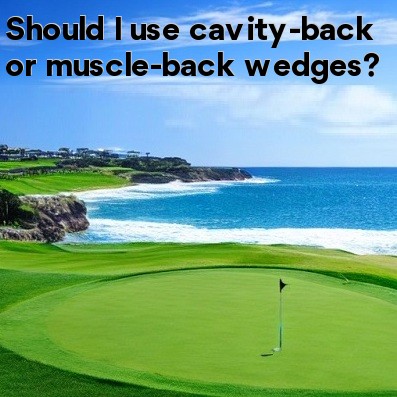
In golf, should I use cavity-back or muscle-back wedges?
When it comes to wedges, golfers have the option to choose between cavity-back and muscle-back designs. Both types of wedges have their own unique features and advantages that can significantly impact a player's performance on the golf course. In this article, we will delve deeper into these two options and help you make an informed decision about which type of wedge is better suited for your game.
Cavity-back wedges
Cavity-back wedges are characterized by a hollowed-out back portion, which redistributes weight around the perimeter of the clubhead. This design results in increased forgiveness and a larger sweet spot. Cavity-back wedges are particularly beneficial for golfers who struggle with consistent ball-striking or those with a higher handicap.
- Forgiveness: The perimeter weighting of a cavity-back wedge increases stability and reduces the effects of off-center hits. This forgiveness can help prevent the ball from veering too far off target.
- Sweet spot: The larger sweet spot in cavity-back wedges means that shots struck slightly off-center still have a chance to perform well. This can be especially helpful when attempting delicate shots around the green.
- Higher launch: Due to the center of gravity being positioned farther back in the clubhead, cavity-back wedges tend to launch the ball higher, making them ideal for shots that require more elevation.
Muscle-back wedges
Muscle-back wedges, also known as blade wedges, have a solid construction without any cavity at the back. These wedges have a compact and traditional shape, with the center of gravity positioned closer to the clubface. Muscle-back wedges offer greater shot-making control and precision for golfers with more advanced skills.
- Shot shaping: The design of muscle-back wedges allows for greater workability and shot shaping. Players with the ability to manipulate their shots will benefit from the control and precision provided by these types of wedges.
- Feel and feedback: With the weight redistributed more towards the center of the clubhead, muscle-back wedges provide enhanced feel and feedback on contact. Experienced players can better analyze their ball striking and make necessary adjustments accordingly.
- Lower launch: The center of gravity being closer to the clubface results in a lower ball flight. This characteristic can be advantageous for golfers looking to control trajectory and distance with their wedges.
Conclusion
Ultimately, the choice between cavity-back and muscle-back wedges depends on your skill level and personal preferences. If you prioritize forgiveness, increased sweet spot, and higher launch, cavity-back wedges may be well-suited for your game. On the other hand, if you value shot-making control, feel, and the ability to shape shots, muscle-back wedges would likely be a better fit.
It's worth noting that many professional golfers and highly skilled amateurs prefer muscle-back wedges due to the additional control they offer. However, it's important to test both types of wedges on the practice range or during a fitting session to determine which option feels more comfortable and provides the desired performance for your specific game.
Ultimately, the choice between cavity-back and muscle-back wedges is a personal one and should be based on your own playing style and preferences. Whichever type of wedge you choose, practicing with it and becoming comfortable with its characteristics will be key to optimizing your performance on the golf course. Happy golfing!




